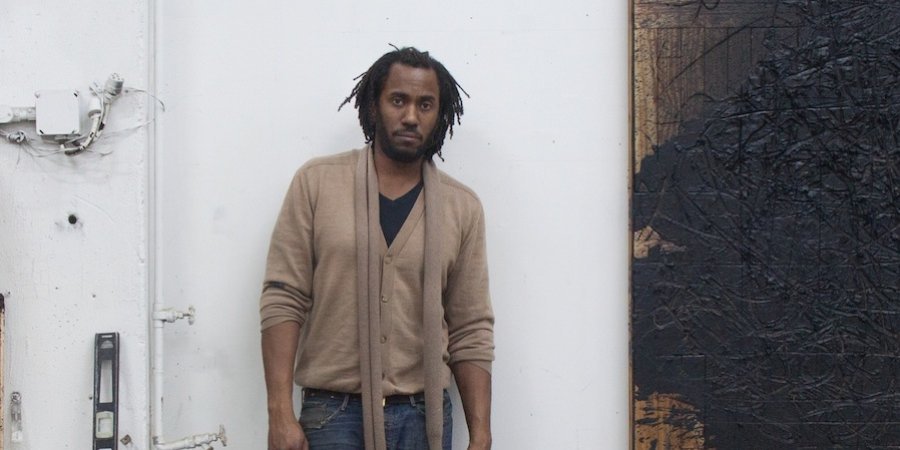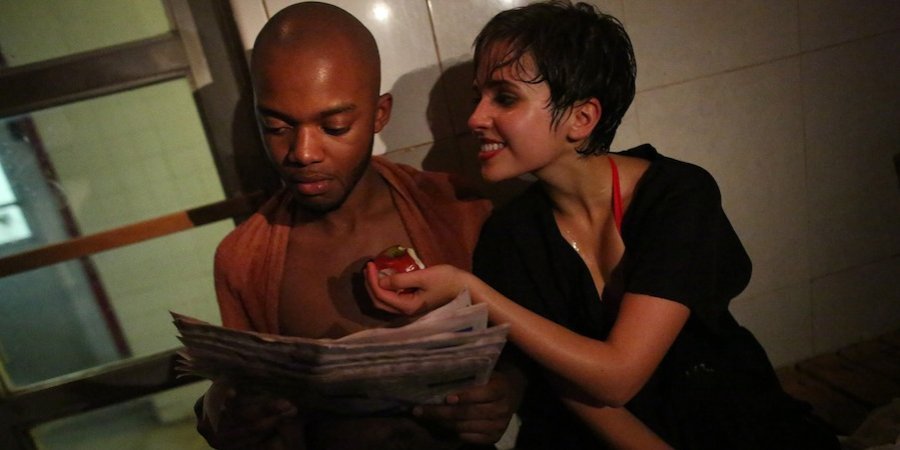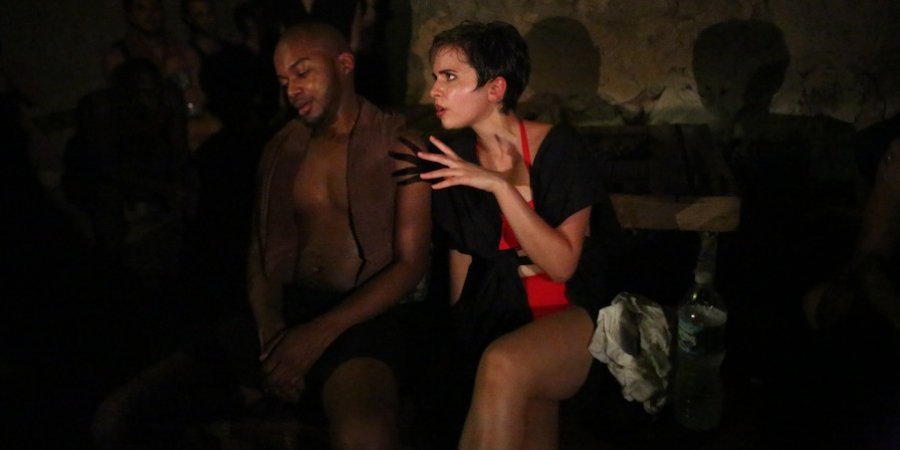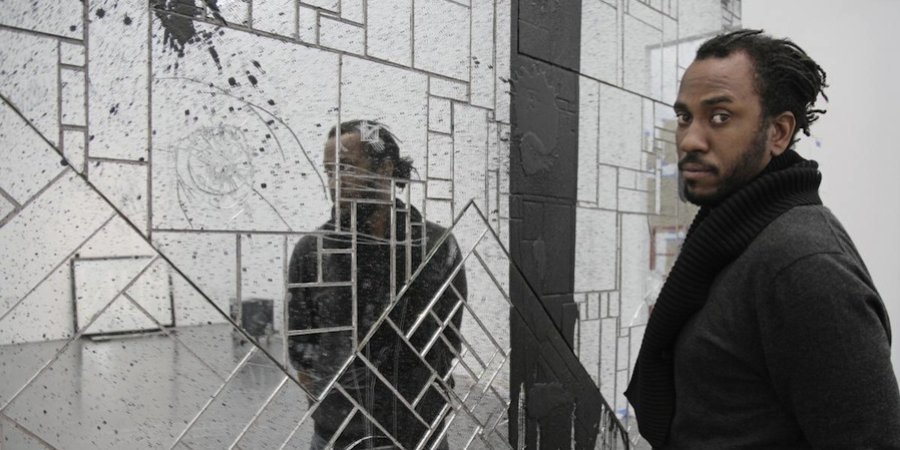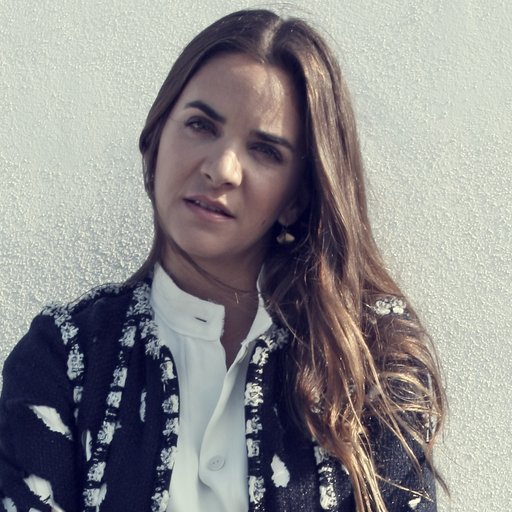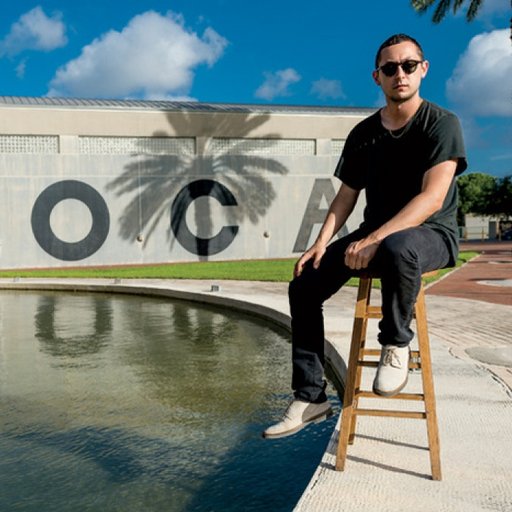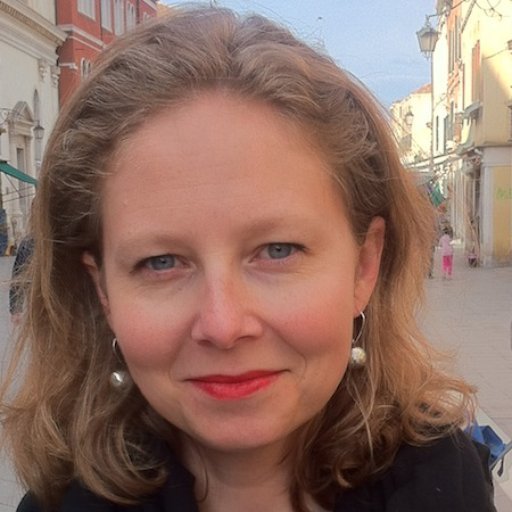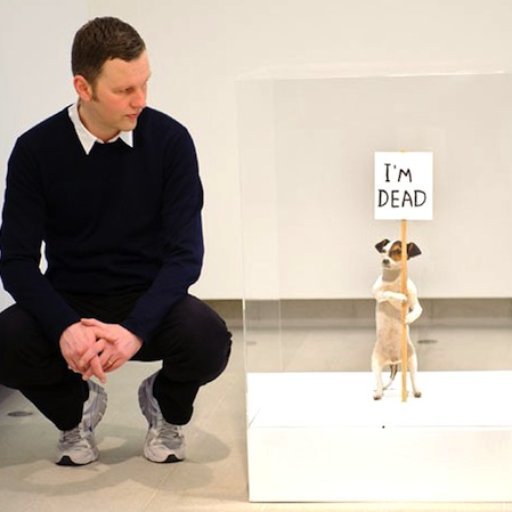An artist whose themes range from the black experience in America to the transcendent properties of art and the individual imagination, Rashid Johnson makes conceptually freighted work that poses questions, cracks jokes, and floats alternatives. His meteoric career began in 2001, when at the age of 21 he was included in an influential group show at the Studio Museum in Harlem called "Freestyle." Since then he has exhibited in the Venice Biennale and had solo shows at the MCA Chicago and SculptureCenter, among other venues. During the 2013 Performa Biennial, he sold out the run of his first performance piece, a restaging of LeRoi Jones's racially explosive 1964 play "The Dutchman" set in the steam rooms of New York's Russian & Turkish Baths.
Artspace editor-in-chief Andrew M. Goldstein sat down with Johnson to discuss the themes in his work and his evolution as an artist.
Let’s start with your upbringing in Chicago. You grew up in a deeply intellectual environment, with a mother who holds a PhD in African History. How did you first come to be interested in art?
There were a couple of moving parts there. My mother was an academic and a scholar, but prior to that she had written a few books of poetry. One was self-published, and the second one, I believe, had a small publishing house attached to it. Neither of the books had critical acclaim, but it was definitely a passion of hers, and so growing up I was very much inspired by her, both as a scholar and a poet. My father also had played with photography quite a bit when he was younger, taking a lot of photographs when he was in Vietnam. My earliest exposure to photography was a box of quite beautiful black-and-white photographs—of his experience, of his friends, of the landscape, of military equipment—that he stored in a closet in my room, and which I became really interested in and went through quite often.
He was also a painter and a sculptor who showed mostly at local art fairs and street fairs, but he never had a tremendous amount of success with his work. He had quite a bit of passion for it, though. So I grew up in this household full of artists, but based on financial necessity they both went into other fields, my mom continuing her studies and becoming a historian and later an administrator—she’s now provost at a small college in the Chicago area—and my father moving into CB radios and electronics.
Did your parents socialize with other Chicago artists, or take you to museums as a child? What was your experience of the larger art scene like?
Well, I grew up in Evanston, and it was a different kind of art scene, a very local art scene with less investment in the history of art and more of a community-flavored atmosphere. I was raised around the street fair, the artist’s booth, the local poetry reading. There was a literary community there through some of my mom’s friends. But there wasn’t a huge focus on institutional art education—the emphasis was more on art classes, creativity, and craft. My first exposure to museums came through school. Like most schools in urban areas around Chicago, they often took us to the Art Institute of Chicago, that being the only museum they really traveled to. When I was younger, the Museum of Contemporary Art Chicago was a much smaller institution and a fairly new one, so it wasn’t so much on our radar.
Notions of black and African identity have been central to your work. Considering you grew up with a mom who held a PhD in African History, how was identity present in your household?
Oftentimes, when I’m asked these questions, I have so many ways of approaching it, because I’m diagnosing it myself as the words are coming from brain to mouth. One thing that has been interesting for me to think about recently is the big role that my stepfather, who is Nigerian, and his family played in my growing up. My mother and my stepfather were together from the time I was five or six and continue to be today. His Nigerian identity, which is an African identity and so is different from African-American identity, was grounded in the immigrant mentality, which is often able to look past society’s failure to embrace you because you’re more focused on the opportunity that society avails you—of being excited to be here to take advantage of those opportunities regardless of the systematically ingrained issues, like our racism, sexism, et cetera, which they chalk up to ignorance and say, “Hey, that’s not my problem.”
Here I’m talking more about my experience than the collective experience, but I think this would hold true for some others as well, of the immigrant who has different concerns than American institutional racism, like the impact of colonization and disease, et cetera. That was very different from the identity of my father and mother, who had more traditional African-American concerns, having dealt for so many years with the larger issues of institutional racism and how those kinds of things had affected generations of their family. So I kind of traffic in that dichotomy, and I think it has given some space in my work to say things at times that maybe, had I not had that kind of more complex experience, I would never have considered saying.
So you have a dual perspective, which lets you see things from the inside but also lets you see things from the outside.
Yeah, in a way. I think we’re all capable of that kind of multiple consciousness. Today, I would even consider it more of a poly-consciousness, the ability to locate yourself in class and race and gender and sexuality, and then, having located yourself in all of those spaces, figuring out an identity that is very much your own as opposed to taking on the agenda of a monolithic identity.
These themes play into your first series of photographs that really gained attention, "Seeing in the Dark," which you started making when you were 20 and first exhibited at the precocious age of 21. How did that series come about?
Coming out of high school, I hadn’t studied much photography—very little, if any. But I had worked a bit for a wedding photographer named Larry Stern, and he had a really great way about him when he was taking his portraits. He taught me that you could communicate with people through photography and have these intimate moments with them, and that kind of portraiture was attractive to me. So I decided to go to school for photography and film—at that time I had a little bit of history with playwriting and I had done some plays for school, so I was interested in that side as well—and I went to Columbia College.
None of the film classes were available, so I registered for my first photography class. I was sure that all the students were going to be really, really informed about photo history—I guess that’s the kind of assumption you make when your mother’s a historian—so before the class started I spent a month in my local library doing a tremendous amount of research on photography. I came across the work of Paul Strand, Henri Cartier-Bresson, Robert Frank, Nicholas Nixon, the laundry list of artists and photographers who had made a tremendous dent in the way we look at pictures today.
So after I did all that research, I came into the classroom not knowing how to use a camera, but knowing a little bit about the discourse, and I think it gave me a real leg up because I realized fairly quickly that while most of the students understood the technical concerns of photography, very few knew about the history of it. As a result, I was able to have conversations with some of the teachers that led them to take an interest in me and take some of the images more seriously.
It’s interesting that you seem to have been drawn to street photography in particular from the beginning.
I knew the idea of street photography, and I discovered fairly quickly that it constituted a very important moment in photo history. And at Columbia College people cherish that kind of photography, the idea of the decisive moment, the man on the street discovering the world through his image-making. I got very interested in that, and when I moved into "Seeing in the Dark" I thought about how I could take ownership of the idea of interaction with the street and then take into a new environment that changed the discourse. It was a kind of investigation of my concerns with the street and the social aspect of how a photograph can invade a person’s space. So I started bringing in homeless people from around the school to photograph, with the school’s studio paying them a small sum. I was very much aware of the problematics of making these kinds of photographs, very much aware of the history in painting and photography of someone from a higher class making art from the issues of the lower class.
Like Walker Evans.
Like Walker Evans. You saw quite a bit of that in his time, with the WPA sending artists into the world to photograph the poor and show their plight and give us an understanding of their conditions. But this goes back to the paintings of Rembrandt and beyond—there’s quite a long list of artists who have participated in this conversation. I did it with the idea that my class distinction from the people I was making photographs of was very specific, and I thought that would be the tension that people would seize on in my work during the critique process. It was a real learning experience to find that when I did bring these images in and they became very successful with the faculty and the student body, there was never a conversation around this class concern. I realized the reason that they didn’t have that reading of my work was that we were both black, because all the men that I made portraits of at this time were black homeless people.
How was it received instead?
It was interesting—we were viewed as being on the same plane, with the photographs being an almost altruistic event, instead of my being critiqued as potentially taking advantage of these people, which I thought was the central conversation to be had around as the body of work. So it was a real learning experience for me how often issues of race can create an obstacle for interpretation in some ways.
This body of work is important, because it made you famous when Thelma Golden included it in her landmark “Freestyle” exhibition at the Studio Museum in Harlem in 2001.
Yeah, it’s interesting, because at the time Thelma came to me asking if I wanted to participate in the show, my work had already led me into more abstract photography and sculpture. So I was introduced to the art world with this older body of work, and it felt like it was because I was playing a role for that particular show, the straight photographer of these sensual, fairly romantic portraits. And I totally appreciated my involvement. I happened to be the youngest artist in that show by a few years, so it was really an eye-opening experience because I saw all these young black artists making really complex bodies of work. I knew that there was something bubbling inside me that asked more questions and provided more contradictions So even though I got a tremendous amount of fantastic feedback, I was less interested in a lot of the offers that came as a result, because I felt my work had transitioned. I pulled back, I went back to Chicago, and I continued to work for a few years, and then I went back to graduate school.
“Freestyle” is best known today for giving birth to the term “post-black art,” which has come to be understood as a kind of art that is straining for new alternatives of identity. As a result you’re associated with this category—your work, in fact, is used to illustrate its Wikipedia entry. Can you talk a bit about this term, and how it relates to your art?
It’s in the lexicon now, but it’s a term that people are very much confused by. I count myself as one of those people. But I don’t find it to be terribly problematic. I think some people do, because a suggestion of an after-black experience can paralyze certain people into the feeling that it’s some sort of subversion of the collective conscious. I don’t necessarily feel that way. It’s not a term or phrase, whatever it is, that I would use to describe myself. There’s been this long history of the idea of the reinvention of the negro. Alain Locke wrote an essay in the 1920s called “The New Negro,” and prior to that you have W.E.B. DuBois and “The Talented Tenth.” You have Harold Cruse and The Crisis of the Negro Intellectual. You have The Rise and Fall of a Proper Negro. You have this idea of rejuvenated identities, of a new variety of black character always cropping up.
“Post-black art” is basically the most recent version of this new-negro-ness. I think it speaks to the idea that the black character seems to always need some sort of reinvention. He or she is constantly in the process of a new discovery. It comes packaged in the idea that there are still firsts to be had, to be the first black person to be on the moon, the first black person to be in the Supreme Court, the first black president—the idea of the black character as a pioneer capable of some sort of pioneering moment. It’s fairly complicated. But it’s interesting to me in a lot of ways, and something that I’ve explored, but with an understanding of the more humorous aspects.
Like with your series "The New Negro Escapist Social and Athletic Club," with photos of well-to-do-looking black men clutching tennis rackets in smoky settings.
I love this idea of the black character being a person who could potentially be rejuvenated and become something new. Just think about how amazing the term “new” is. It suggests that somehow the old version had some potential flaw that has been resolved by this new version. There’s a cleanliness to “new”—it’s fresh out the box, completely unmolested. It’s like, “Oh, there’s a new black? How exciting—I want to meet that.” So this idea of this unmolested conscious space is one that I’m interested in exploring, both for the potential contradictions and the potential absurdity as well as the potential for it be an interesting and valuable space to explore seriously.
Now, of course, you’re probably best known for your sculptures and paintings. How did your work evolve from photography to sculpture?
It happened over a period of, I don’t know, ten years. I was always interested in sculpture, in making objects. Even as an undergrad, when people were looking at my photography, I was making a lot of sculpture. As I continued to introduce it, as it continued to be something that was pushing the language of what I was doing in interesting directions, so it just became part of my language. It’s almost like that Rosalind Krauss book Art in the Age of Post-Medium Condition. You finally realize that artists are not necessarily so boxed by medium specificity, that there was a complicated whirlwind of things happening over the past 40 years that freed artists from a specific commitment to a specific kind of medium or approach to art-making. I take the Krauss term “condition” to describe a fault or a disease, and once I realize that I was suffering from this condition, once I realized that having a singular commitment to a particular mode was not in the cards for me, I let all of the things I was doing bleed together. That’s when I started making the work that I find to be pushing in the direction of what I’m trying to do today.
Your sculptures, with their stacks of books and rows of album covers and smears of wax, absolutely fuse painting, sculpture, and photography. How did you start using found objects and found photographs?
When I started looking at album covers, and I almost couldn’t believe it—there were so many successful images I could borrow, and it would allow me to still participate in the language of photography. I could look to antecedents of what I was doing, like Richard Prince’s cowboys and Sherrie Levine’s remakes of Walker Evans and John Baldessari’s work. As I became more exposed to conceptual practice, I realized I don’t necessarily need to be the creator of an image to be the employer of an image. When that sank in, I realized that it was a very interesting way to participate in photography. The tools of photography are one thing, the actual images are totally different, and the way you utilize either is a commentary on photography.
Where do you find your raw materials, the albums and books and the rest?
A lot of it is stuff that I’m actually involved with—the albums I’m listening to, the book I stole from my mother’s shelf as a child—and therefore it stops being this conceptual conundrum and becomes a personal investment in narrative. I often use these things in multiples, which is really important to me. I’m less interested in this idea of the found object as just this kind of precious individual moment, or as a delivery system for knowledge or entertainment, than I am in using it as a mark-making tool—where an object will potentially be repeated 15, 20, 35 times, so it becomes about line, about Minimalism, as well as about how information is delivered and what multiplicity begins to suggest. A lot of the materials are chosen based on that interplay of concerns.
Many of your sculptures function as shelving units for your objects, making them a commentary on issues of display and curation. How do you choose which objects go with which?
It’s absolutely about display—it’s kind of an amazing act to develop a place to house your things. I call them “something to put something on,” which is really a reference to a Lawrence Weiner book. And I’ve collected so many things that there are so many crosscurrents of language and contradiction throughout my studio, whether it be a rap album next to W.E.B. DuBois’s Souls of Black Folks, or a gold rock that I had painted next to a brass urn. It’s all this language that, when combined, produces a complicated kind of narrative. I’ve always felt that my individual interests, as most probably feel as well, are filled with contradictions. I love the Beatles’ White Album and I love the book Black Rage. These are not poles that seem like they would go together necessarily, but in my mind, they do, and I think this really speaks to the individual’s experience and how you’re not necessarily born into one conscious space.
So the sculptures create so much opportunity for movement and evolution, and again, they come back to the term “newness,” right? Another way to explain it would be “nowness.” How do you consider yourself in a “now” space today versus 30 days ago? What did you know before this conversation? Where is your “now” space now? How is the information that you gathered in the last however many years, minutes, milliseconds going to affect you. I realized that if I could just start to locate some of the things I collected and thought about and employed and learned from that I could create a really honest of gesture of where I was as an individual, as an artist. It’s kind of simple, but in so many ways it’s probably one of the most honest things I’ve ever done.
Do you believe people read the pieces as autobiographical? Or do you think there can be some confusion in their reception, just as with your photographic series?
It becomes an investigation. What is the message? What is he delivering to us? How are we supposed to read this? Are we supposed to be doing this left to right? Top to bottom? For me, it’s not a puzzle as much as it is a really genuine gesture that says, “This is what I was doing. Let’s all look at it and figure out essentially what the fuck is going on with me and what gives any agency to the history of a people, the history of man.” Right? Art should be about the bigger issues in life. Life, death, sex, taxes, race, gender. The best art has something to say about the human condition.
There’s also, notably, a thread of magic that goes through your work. You use these totemic objects and materials in your sculptures, like black wax and shea butter and shells and marks from branding irons. Where do these stem from?
You know, I was always interested in mysticism, and it was born of a certain kind of naiveté. When I was a really young man I would go to down to my mother’s library and I would come across a lot of the titles of the books on her shelf as well as the other materials that she was keeping on the shelves and some of my father’s materials. It all coalesced into a very complex narrative. For instance, seeing Derrida’s The Gift of Death on the shelf when you’re 12, you’re like, “What the fuck is this?” It’s incredibly complicated to breathe in that title as a very young person, and to have that sitting near bronze versions of your baby shoes and several other books. It was a very extensive library: Heidegger, Faulkner, Harold Cruse, Ellison’s Invisible Man next to Catcher in the Rye, really several different canons mixed together.
Then going from that set of things to my father’s home, where the shelves were filled with CB radios, the Tao Te Ching, The Autobiography of Malcolm X, just went beyond my ability to understand how these things were related, and created for me a strange, mystic space. The only way for me to reproduce that as an adult was to suggest a certain kind of mysticism involved in materials as well as the conjuring of language from the albums and books, along with the other objects that were around the house. I tend to prefer for everything in my world not to be viewed as autobiographical, because that reaches into my childhood exclusively and there are so many things I’ve been exposed to since then that have been formative. But I do have to say that, as a launch pad, it was fairly influential.
Lately, you’ve been getting into video art, picking up a form that you diverged from in art school. You did The New Black Yoga, which is a new vocabulary you’re working with. What was the genesis of that project?
You always go back to where you started at some point. But it was actually born of an experience I had when I was living in Berlin and planning a show at a gallery there. I was dealing with a lot of anxiety, both from living for the first time abroad and being newly married and thinking about how we would start to evolve our family and where we would live—the big questions in life. A doctor of mine suggested I try to yoga because it’s great for your breathing and helps treat anxiety without medication, so I went to a class and the yoga instructor said to me, “This is going to be very difficult for you because the class is in German.” And I thought to myself, well, I’m sure it’s going to be physically difficult, but I will just copy what the other people are doing. I soon realized that when you can’t follow in your native language, it’s very difficult to follow through with a lot of the movements.
From that, I started thinking about getting tapes and this do-it-yourself yoga thing was born. I started jokingly to call it “black yoga,” and I found a young dancer and started to choreograph these movements that were inspired by both yoga and these kung fu movements that I had seen as a kid. I quickly made this film, which was called Black Yoga. Then I followed that up two years later with The New Black Yoga, a film I shot in Long Island about these young black kids who are, in theory, on vacation in Long Island performing this black yoga. It was kind of meant to suggest this black upper-class experience married to this wild, complex dance-yoga-martial arts performance. It was actually recently purchased by the Guggenheim.
As a closing question, what do you think is the artist’s role in society?
I think it can be different for every artist, and that’s really important. I’m excited that there are artists who think their role in society is to help change come into being. I’m glad that those artists exist. I’m glad that there artists who believe that their role is to be aesthetes and to make the world more beautiful. I think that there are artists who believe that their political insights and agendas will change culture. I think all of those things are valuable ways of approaching art and expanding our comprehension of art. My role, as it lives today, is to investigate and continue to ask myself questions. As you have an opportunity to answer questions, more questions crop up. Not to be a traditional deconstructionist, but I do believe the more questions you ask, the more options people have for how to answer them. I feel like right now, as an artist, I am as much a question-asker as I am someone who could potentially help resolve or answer those questions.











